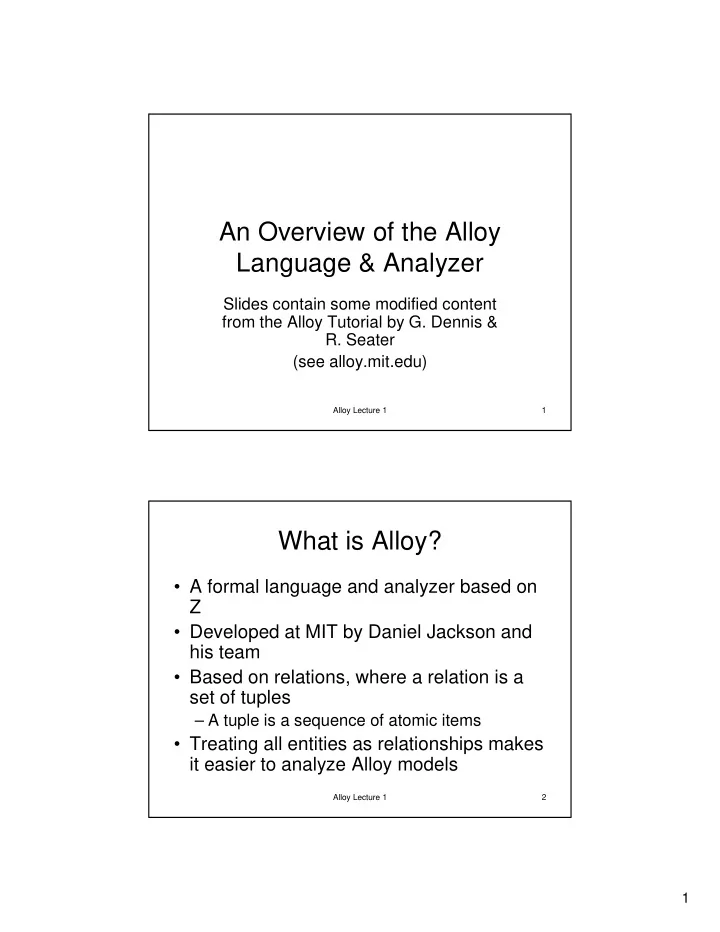

An Overview of the Alloy Language & Analyzer Slides contain some modified content from the Alloy Tutorial by G. Dennis & R. Seater (see alloy.mit.edu) Alloy Lecture 1 1 What is Alloy? • A formal language and analyzer based on Z • Developed at MIT by Daniel Jackson and his team • Based on relations, where a relation is a set of tuples – A tuple is a sequence of atomic items • Treating all entities as relationships makes it easier to analyze Alloy models Alloy Lecture 1 2 1
Understanding Alloy • Three parts – The logic • First-order expressions on relations • Relations of relations (i.e., higher-order relations) are not supported • States and executions are described using constraints (like Z, OCL) – The language • Provides structure and “syntactic sugar” – The analysis mechanism • Takes the form of constraint solving • Simulation: Find instances that satisfy a set of constraints • Checking: Find a counterexample that violates a constraint Alloy Lecture 1 3 Structure of an Alloy Model module tour/addressBook1h ------- Page 14..16 Module header sig Name, Addr { } Signatures: A sig Book { signature declares a addr: Name -> lone Addr set of atoms } • can also pred show [b: Book] { introduce field #b.addr > 1 #Name.(b.addr) > 1 • each field } represents a run show for 3 but 1 Book relation pred add [b, b': Book, n: Name, a: Addr] { commands are b'.addr = b.addr + n->a in red } Constraint paragraphs: pred del [b, b': Book, n: Name] { b'.addr = b.addr - n->Addr specifies } constrainst (e.g., assert delUndoesAdd { invariants) all b, b', b'': Book, n: Name, a: Addr | no n.(b.addr) and add [b, b', n, a] and del [b', b'', n] implies Assertions: b.addr = b''.addr properties that are } expected to hold // This command should not find any counterexample. check delUndoesAdd for 3 Alloy Lecture 1 4 2
A world of relations … Everything is a relation in Alloy – A relation is a set of tuples • sets are unary (1 column) • binary relation relations names = {(B0, N0), Name = {(N0), (N1), (N2)} (B0, N1), Addr = {(A0), (A1), (A2)} (B1, N2)} Book = {(B0),(B1)} • ternary relation addrs = {(B0, N0, A0), • scalars are singleton sets (B0, N1, A1), myName = {(N1)} (B1, N1, A2), yourName = {(N2)} (B1, N2, A2)} myBook = {(B0)} Alloy Lecture 1 5 Analysis in Alloy • Analysis: find some assignment of values (relations) to variables that makes a constraint true • You can ask Alloy to perform 2 types of constraint/assertion checks – Find an instance of a model that satisfies constraints (use the run command) – Find an instance in which an assertion does not hold; the instance is called a counterexample (use the check command) • Analysis is made tractable by restricting the space in which it searches for solutions – Defining the restricted search space is called scope setting Alloy Lecture 1 6 3
Alloy language elements: Signature Fields • Signature field – A field in a signature is a relation in which the domain is a subset of the signature elements • sig A {f: e} – f is a binary relation with domain A and range given by expression e – f is constrained to be a function – (f: A -> e) Alloy Lecture 1 7 Alloy language elements: Constraints • A fact is a constraint that is intended to always hold • An assertion is a constraint that is intended to follow from facts • A predicate is a reusable constraints, i.e., it is used to express facts and assertions • A function defines a reusable expression Alloy Lecture 1 8 4
Alloy language elements: the run command pred p[x: X, y: Y, ...] { F } run p scope • instructs analyzer to search for instance of predicate within scope pred show [b: Book] { #b.addr > 1 #Name.(b.addr) > 1 } run show for 3 but 1 Book Alloy Lecture 1 9 Example (from tutorial) sig Platform {} there are “Platform” things sig Man {ceiling, floor: Platform} each Man has a ceiling and a floor Platform pred Above[m, n: Man] {m.floor = n.ceiling} Man m is “above” Man n if m's floor is n's ceiling fact {all m: Man | some n: Man | Above (n,m)} "One Man's Ceiling Is Another Man's Floor" Alloy Lecture 1 10 5
assert BelowToo { all m: Man | some n: Man | Above (m,n) } "One Man's Floor Is Another Man's Ceiling"? check BelowToo for 2 check "One Man's Floor Is Another Man's Ceiling" counterexample with 2 or less platforms and men? – counterexample found Alloy Lecture 1 11 A counterexample (from MIT Alloy tutorial) Alloy Lecture 1 12 6
Recommend
More recommend